|
|

The SS7 signaling architecture consists of three essential components, interconnected via signaling links. Table 2-1 lists these components and their associated symbols.
| Abbreviation | Name | Symbol |
|---|---|---|
SSP | Signal Switching Point - or - Service Switching Point | |
STP | Signal Transfer Point | |
SCP | Signal Control Point - or - Service Control Point | |
SSPs create packets (signal units) and send those messages to other SSPs, as well as queries to remote shared databases to find out how to route calls. They can originate, terminate, or switch calls.
The SSP uses the calling party information (dialed digits) to determine how to route the call. It looks up the dialed digits in the SSP routing table to find the corresponding trunk circuit and terminating exchange. The SSP then sends an SS7 message out to the adjacent exchange requesting a circuit connection on the trunk which was specified in the routing table.
The adjacent exchange sends an acknowledgement back, giving permission to use that trunk. Using the calling party information contained in the setup info, the adjacent exchange determines how to connect to the final destination. This might require several trunks to be set up between several different exchanges.
SSP manages all of these connections until the destination is reached.
STPs route SS7 messages (based on information contained in the message format) to outgoing signaling links over the SS7 network. They are the most versatile of all the SS7 entities, and are a major component in the network.
There are three levels of STPs. (See Figure 2-1.)
Messages can be passed to an International STP, but can not be converted by the National STP. Protocol converters often interconnect a National and an International STP by converting from ANSI to ITU-TS.
All nodes connecting to an International STP must use the ITU-TS protocol standard.
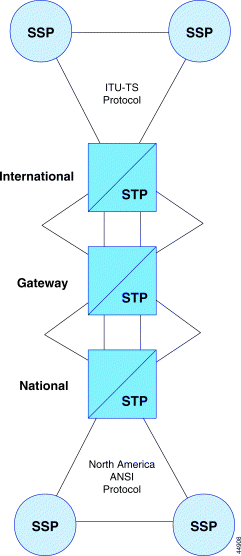
A Gateway STP also serves as an interface into another network's databases, such as from an interexchange carrier (IXC) to an end office. The Gateway STP can also be configured to screen for authorized users of the network.
Gateway STPs also provide measurements of traffic and usage via the following means:
An SCP is usually a computer used as a front end to a database system. It is an interface to telco databases, not usually to other, application-specific databases. (Refer to Table 2-2.)
 |
Note Some new SCP applications are being implemented in STPs. |
| Abbreviation | Name | Description |
|---|---|---|
BSDB | Allows companies to create and store proprietary databases, as well as create private networks. | |
CMSDB | Provides information relating to call processing, network management (prevent congestion), call sampling (create reports for traffic studies), and the routing, billing and third-party billing for 800, 976 and 900 numbers. | |
HLR | Used in cellular networks to store subscriber information. | |
LIDB | Provides billing instructions. | |
LNP | Allows people to change telco service providers but keep their same telephone number. | |
OSS | Associated with remote maintenance centers for monitoring and managing SS7 and voice networks. | |
VLR | Used when a cell phone is not recognized by the mobile switching center (MSC). |
SS7 networks are built to be highly reliable and redundant. Link diversity is built into the network design, providing multiple signaling paths, so that there is no single point of failure. This practice ensures that redundant links have the capacity to handle all rerouted network traffic.
Any signaling that an SSP or SCP needs to send to any other node in the SS7 network is sent on one of its A-links to its "home" STP, which processes and routes the message along its way. Messages addressed to an SSP or SCP are routed to its "home" STP, which forwards them to the addressed node over its A-links. (See Figure 2-2.)
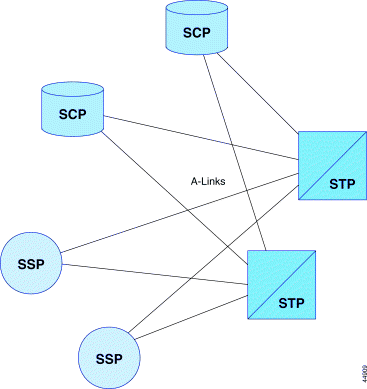
Bridge links (B-links) are the quad of links interconnecting peer pairs of STPs. Diagonal links (D-links) are the quad of links interconnecting mated pairs of STPs at different hierarchical levels. (See Figure 2-3.)
Since the SS7 network has no clear hierarchy, these links are referred to as B-links, D-links, or B/D-links.
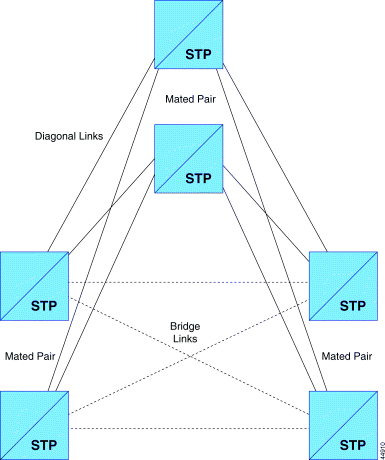
Cross links (C-links) interconnect mated STPs and are used to enhance the reliability of the signaling network not regularly used by SS7 traffic. (See Figure 2-4.) They are used only when there has been a link failure which causes an STP to have no other route.
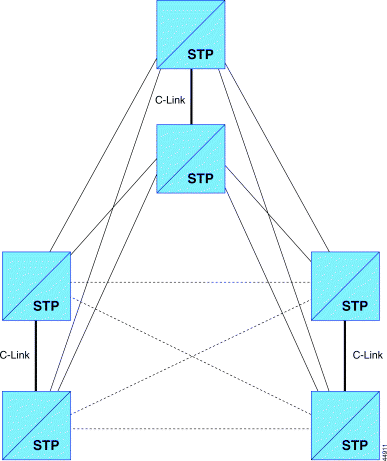
 |
Note E-links are not usually provisioned, unless cost/reliability trade-offs justify the expense. |
Fully associated links (F-links) directly connect two signaling end points (SSPs and/or SCPs). They are not usually used in networks with STPs because they allow associated signaling only, thus bypassing the security features provided with an STP. (See Figure 2-5.)
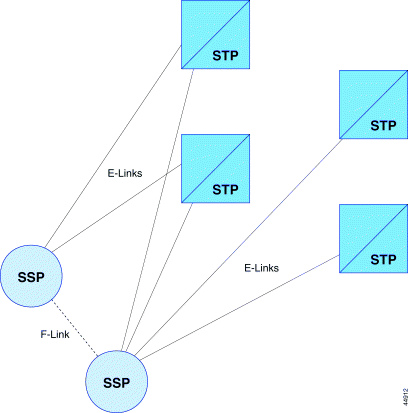
Links are put into groups called linksets. Up to 16 links can be assigned to one linkset. All links in a linkset must have the same adjacent node. (See Figure 2-6.)
Switches will alternate traffic across all links in a linkset to ensure equal usage of all facilities in the network.
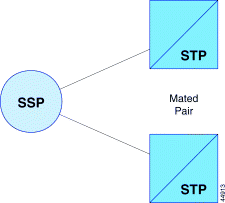
If possible, links should be terrestrial. Satellite links can be used but are not preferred because of the inherent delay.
Alternate linksets are set up to provide backup paths when congestion occurs in the network. When a link fails, all other links within the linkset must take over. (See Figure 2-7.)
 |
Note A maximum of 10 minutes downtime per year is allowed for any one linkset, to protect network integrity. |
If an SS7 entity such as an STP fails, its mate assumes the full traffic load. For this reason, SS7 entities are designed to send less than 40 percent of the traffic on any given link. If an entity fails at 40-percent capacity, there is still enough room on its mate for it to carry the entire traffic load of the mated pair.
The signaling link interface type will depend on the type of equipment used with the links. The V.35 interface is used to connect from the data service unit (DSU) to the signaling point. V.35 can also be used from a digital system cross-connect frame (DSX).
 |
Note V.35 needs a clock source. Data links are 56 or 64 Kbps. |
In SS7, addresses are assigned using a three-level hierarchy.
Any node in the SS7 network can be addressed by the three-level number defined by its network, cluster, and member numbers. Each of these numbers is an 8-bit number assigned a value from 0 to 255. This three-level address is called the point code of the signaling point.
Network numbers are relatively scarce. Companies are expected to meet size requirements in order to be assigned a network number.
 |
Note Network number 0 is not available and 255 is reserved. |
Smaller networks can be assigned one or more clusters within network numbers 1, 2, 3 and 4. The smallest networks are assigned point codes within network number 5. The cluster to which they are assigned determines the state or province they are in.

1. Name the three essential SS7 components.
2. Which SS7 component functions like an SS7 network router?
3. Which SS7 component originates, terminates and switches calls?
4. Identify the three levels of STPs.
5. What interconnects a national and international STP?
6. Which protocol does an interjectional STP use?
7. Which SS7 component provides traffic measurements?
8. Which SS7 components provides interfaces to telco databases?
9. Name three types of telco databases in the SS7 network.
10. Which two databases are used in cellular networks?
11. What is meant by link diversity?
12. What does an A-link interconnect.
13. What are B- and D-links used for?
14. Are C-links used all of the time?
15. Define linkset.
16. Name two types of link interfaces. Which is the most common?
17. What is a route?
18. Define the three components of a point code.
![]()
![]()
![]()
![]()
![]()
![]()
![]()
![]()
Posted: Sat Sep 28 13:44:52 PDT 2002
All contents are Copyright © 1992--2002 Cisco Systems, Inc. All rights reserved.
Important Notices and Privacy Statement.